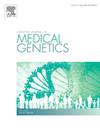涉及NPHS2的1号染色体单代同工二体与类固醇抵抗性肾病综合征合并肾功能衰竭
IF 1.7
4区 医学
Q3 GENETICS & HEREDITY
引用次数: 0
摘要
类固醇抵抗性肾病综合征是一种罕见的疾病,由早期严重蛋白尿伴低白蛋白血症、高脂血症和可能的水肿所定义,通常由影响肾小球滤过屏障建立和维持的基因的致病变异引起;其中,NPHS1 (19q13.12)和NPHS2 (1q25.2)是迄今为止涉及的两个主要常染色体隐性基因。我们报告一名23岁女孩因继发于局灶节段性肾小球硬化的类固醇抵抗性肾病综合征而转诊至我院,发病年龄为5个月。下一代测序分析显示纯合子致病变异c.413G >;A在NPHS2基因中,导致氨基酸改变p.a g138gln (rs74315342)。通过分离研究,父本为同种变异的杂合载体,而母本为野生型。为了研究母体等位基因可能的染色体重排,进行了snp阵列分析,在先证者中发现了父系1号染色体同位体。1号染色体的单系二体与特定表型无关,但揭示了常染色体隐性NPHS2突变的父系遗传,并使其达到纯合状态。总之,本临床报告证明了亲代分离分析的重要性,特别是在隐性疾病患者中,既可以寻找疾病特定的遗传原因,又可以适当地估计家族复发的风险。本文章由计算机程序翻译,如有差异,请以英文原文为准。
Uniparental isodisomy of chromosome 1 involving NPHS2 in steroid-resistant nephrotic syndrome with renal failure
Steroid-resistant nephrotic syndrome is a rare condition defined by early severe proteinuria associated with hypoalbuminemia, hyperlipidemia and possible edema, is usually caused by pathogenic variants in genes affecting the establishment and maintenance of the glomerular filtration barrier; among these NPHS1 (19q13.12) and NPHS2 (1q25.2) are by far the two main autosomal recessive genes implicated. We report on a 23-year-old girl referred to our hospital for Steroid-resistant nephrotic syndrome secondary to focal segmental glomerulosclerosis, onset at the age of 5 months. Next Generation Sequencing analysis showed the homozygous pathogenic variant c.413G > A in the NPHS2 gene, leading to the amino acid change p.Arg138Gln (rs74315342). By segregation study the father resulted heterozygous carrier of the same variants, while the mother emerged as wild-type. In order to investigate a possible chromosomal rearrangement in the maternal allele, SNP-array analysis was performed, revealing a paternally chromosome 1 isodisomy in the proband. Uniparental disomy of chromosome 1 is not associated with a specific phenotype but unmasks the autosomal recessive NPHS2 mutation paternally inherited and bring it to a homozygosity state. In conclusion, this clinical report demonstrates the importance of parental segregation analysis, especially in patients with recessive conditions, both to search for the disease specific genetic cause and to appropriately estimate the risk of recurrence in the family.
求助全文
通过发布文献求助,成功后即可免费获取论文全文。
去求助
来源期刊
CiteScore
4.10
自引率
0.00%
发文量
193
审稿时长
66 days
期刊介绍:
The European Journal of Medical Genetics (EJMG) is a peer-reviewed journal that publishes articles in English on various aspects of human and medical genetics and of the genetics of experimental models.
Original clinical and experimental research articles, short clinical reports, review articles and letters to the editor are welcome on topics such as :
• Dysmorphology and syndrome delineation
• Molecular genetics and molecular cytogenetics of inherited disorders
• Clinical applications of genomics and nextgen sequencing technologies
• Syndromal cancer genetics
• Behavioral genetics
• Community genetics
• Fetal pathology and prenatal diagnosis
• Genetic counseling.

 求助内容:
求助内容: 应助结果提醒方式:
应助结果提醒方式:


